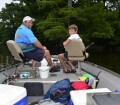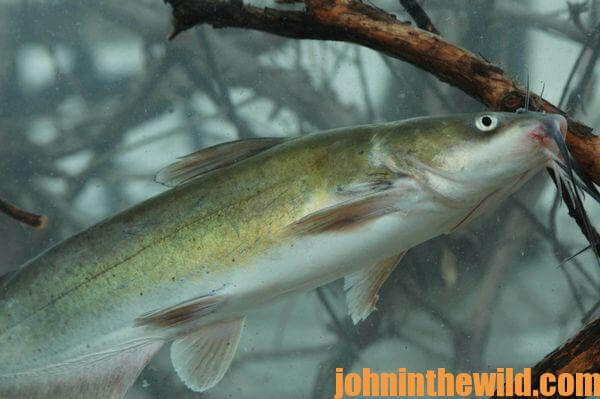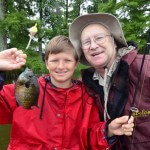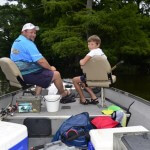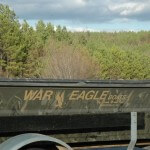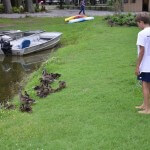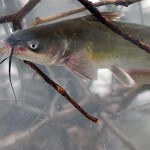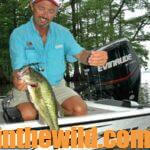John’s Note: The origins of Blue Bank Resort in Hornbeak, Tennessee, near Tiptonville (www.bluebankresort.com, http://www.facebook.com/blueBankResort, 877-258-3226) started in the early 1900s when today’s owner’s grandmother, Kohoma Hayes, owned and operated the Reelfoot Hotel. Through the years the motel, the restaurant and the guiding business have gone through several transitions, but always with the Hayes family still owning Blue Bank Resort. Then newly-renovated motel also features a 13-man hot tub and a big swimming pool, besides a restaurant featuring delicious food that draws customers from miles around. Blue Bank Resort offers guides for all types of fishing and duck and goose hunting, as well as eagle viewing. 
I’m a multi-species fisherman, because this is the way my dad taught me to fish.
If the bass weren’t biting, we’d fish for bluegills. If the bluegills weren’t biting, we’d fish for catfish. If the catfish weren’t biting, we’d fish for white bass. But before any fishing trip was over, we’d usually have a cooler full of some kind of eating fish. So when I took my 13-year-old grandson, Conner Hudson, to Blue Bank Resort on Reelfoot Lake, I explained to chief guide Billy Blakely, “I don’t care what we catch as long as we can keep Conner’s rod bent throughout most of the day.” Blakely smiled and said, “Don’t worry John. One of the reasons I use the 2170 Black Hawk War Eagle is: I can carry enough fishing stuff to make sure we catch some fish. This boat is built strong and safe. We can fish in 2 feet of water or 10 feet comfortably. I’ll keep Conner on the front deck with me sitting right beside me. I’ll make sure we catch fish. We’ll put out some YoYos first. The YoYos will be fishing for catfish while we’re somewhere else fishing.”
As we went out on Reelfoot, Blakely headed for cypress trees with limbs that hung out over the water. On the way to put out the YoYos (Mechanical Fisher, “http://www.rockingaltd.com/mfish.html” he asked Conner to break big night crawlers into about three pieces and then bait the hooks we’d use for catfish. Conner hadn’t had a lot of exposure to live bait fishing. Pinching one night crawler into three different catfish baits was a new experience for him. At first he was a little hesitant. But once he got the hang of it, he learned how to break the worms into catfish-size bites. He watched as Blakely tied the YoYos on to tree limbs hanging out over the water and put the hooks with the worms on them about 2-3 feet deep.
When the catfish takes the worm on a yoyo, it sets off a trigger that releases a spring inside the YoYo and sets the hook on the cat. When the catfish tries to swim away, the spring tightens, pulling the string attached to the hook even tighter and the catfish back to the base of the tree. The more YoYos you put out, the more cats you can catch. As Conner watched, Blakely baited hooks, tied YoYos onto trees and maneuvered his War Eagle boat in and out of the standing cypress trees. Conner also learned a quick and easy way to catch catfish without holding a pole. Each time we checked our YoYos, Conner would go to the front of the boat with his dip net, dip up the catfish, hold the catfish in the net while Blakely showed him how to unhook it, get his picture taken and put the catfish in the livewell. Conner was like a little fishing sponge – soaking up all the knowledge and learning all he could about how to catch cats.
Then we moved out to the big water in the middle of the lake, baited with night crawlers and used floats to suspend our baits just above the sunken trees, logs and stumps in the bottom of the lake. Blakely told Conner, “Back in the 1800s there were a series of earthquakes that caused a big crack in the earth right here where we’re fishing. All the trees on the sides of and around this big crack in the earth caused by the earthquake fell into the crack. This big hole in the earth that had all the trees in it went all the way out to the Mississippi River. Normally, the Mississippi River flows from the north to the south. But when the earthquake created this big hole in the earth, the Mississippi River started flowing backwards from the south to the north and filled up this hole that today we call Reelfoot Lake. When the Mississippi River started filling up Reelfoot Lake, all the fish in the Mississippi River got dumped into Reelfoot Lake. Those trees, logs and stumps created a great place for bass, bluegills, catfish and crappie to live. So, right here where we’re fishing is where that earthquake made this big hole that’s now Reelfoot Lake.”
Conner’s intensity of listening to the story of Reelfoot was only interrupted when his bright red cork sank. Conner set the hook and yelled, “I got him. I got him. I got him.” As Conner reeled, he got coaching from both sides – me on one side and Blakely on the other. “Keep your rod tip up, Conner,” Blakley coached. “Reel, reel, reel,” I cheered as Blakely got the net and prepared to dip the catfish. “I caught him all by myself,” Conner announced with the pride only a young fisherman can know when he catches a nice 1- or 1-1/2-pound catfish.
When fishing in the middle of the lake waned, we pulled up anchors and ran to the standing cypress trees where we had put out YoYos for the catfish. Conner dipped up four more 2-pound cats. Fishing the YoYos and in the middle of the lake produced about eight catfish, in about 1-1/2-hours. We re-baited the YoYos and then were off to look for another bluegill bed.
To get John E. Phillips’ Kindle eBook “Reelfoot Lake: How to Fish for Crappie, Bass, Bluegills and Catfish & Hunt for Ducks” click here to get these books.
For a print version of “Reelfoot Lake: How to Fish for Crappie, Bass, Bluegills and Catfish & Hunt for Ducks” go to www.bluebankresort.com, or call 877-258-3226.
Share this page with a friend!
About the Author
John Phillips, winner of the 2012 Homer Circle Fishing Award for outstanding fishing writer by the American Sportfishing Association (ASA) and the Professional Outdoor Media Association (POMA), the 2008 Crossbow Communicator of the year and the 2007 Legendary Communicator chosen for induction into the National Fresh Water Hall of Fame, is a freelance writer (over 6,000 magazine articles for about 100 magazines and several thousand newspaper columns published), magazine editor, photographer for print media as well as industry catalogues (over 25,000 photos published), lecturer, outdoor consultant, marketing consultant, book author and daily internet content provider with an overview of the outdoors. Click here for more information and a list of all the books available from John E. Phillips.


